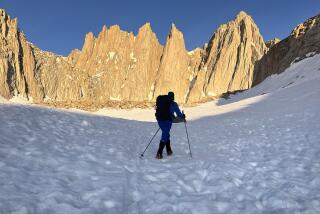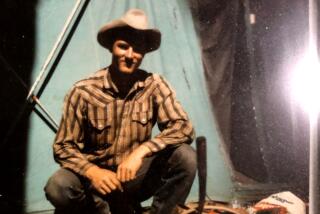Hunting elk in quiet, snowy Wyoming
- Share via
THE SIERRA MADRE RANGE, WYO. — The guy ropes on our tent were frozen as hard as steel cables. We hadn’t seen the sun in days. Each night had brought more snow to the western slopes of Wyoming’s Sierra Madre range.
My wife, Susie, and I welcomed the new snow every morning as a fresh canvas for elk tracks. It was our fifth day of hunting and we had only two days left. Things were taking on a no-nonsense, businesslike feel. We had no elk so far and were running out of time.
The wood stove inside the tent kept things warm that morning as Susie fried bacon and eggs in a Dutch oven. She shoveled the food into plastic bowls, over broken hardtack biscuits. A dash of hot sauce, and breakfast was served.
The new snow covered the two-track road as we drove north from camp in the predawn darkness. The truck churned and bucked in four-wheel-low range. I cradled my green plastic bowl of eggs between my knees. Susie sat next to me in the cab crowded with maps, boxes of ammo, binoculars and spare clothing.
Suddenly we saw two elk on the road, ghostly figures that seemed to float in the headlights. Their eyes reflected back as yellow-green dots. The elk soon wheeled into the thick, dark forest, moving east toward the mountain peaks.
I pulled off the road and cut the engine. We had a few minutes before it would be light enough to shoot. We ate our food, chugged hot coffee and forgot about our plans to look elsewhere; we would hunt here.
The two elk we had spooked had gone uphill into the thick, matted forest of spindly pine. But there were many other fresh tracks that crossed the road and led down into a canyon that held a small creek running to the west.
Shouldering our packs and rifles, we followed the tracks. Soon, we split up. Susie stayed higher on the slope as we moved slowly along the side of the canyon.
The forest was thinner there. Barren aspens stood above sagebrush like spindly sentinels in the dim, blue light before the dawn. Low, dark clouds moved fast across the sky, their shapes constantly shifting under the incessant west wind.
Morning light shifts quickly in snow-covered mountains. One moment it was too dark to see and daylight seemed a shivering eternity away. And then, suddenly, it was light enough to shoot.
I watched the trees carefully as I pushed through the snow about half a mile from the road. Then something triggered my attention.
It was the form of an animal, standing half-obscured in the brush perhaps 150 yards away. It was a cow elk -- what we had been hunting for all week.
I quietly levered open my rifle and loaded the cartridge I had been carrying in my bare right hand. I looked for a tree to lean against to steady the rifle for the shot, but there was none. And I was standing in brush that wouldn’t let me sit or lie down for a steadier position. I would have to take the shot offhand -- standing with no support -- or pass it up.
I carried a single-shot Ruger chambered for a .338 magnum cartridge. It’s a heavy piece to carry all day but it holds steady when I need it to.
I put my left arm through the shooting sling. The cross hairs of the 4-power scope hung correctly on the elk’s chest as I willed myself to squeeze the trigger gently and not disturb the aim.
The abrupt roar of the rifle broke the stillness of the winter morning. The burning powder flashed orange in the low light. The recoil of the rifle carried it up and I lost my view of the elk. But I knew that I had shot well.
Three other elk ran out of the drainage below me, moving through the snow-covered sagebrush, back up the canyon toward the road. Susie was uphill and couldn’t shoot: I was between her and the animals.
I reloaded my rifle and moved into the aspens to look for my elk. Although I knew the shot had been good, there was still the familiar sense of relief when I saw the animal lying dead on the ground. I prodded its open eye with the muzzle of the rifle and watched to make sure it didn’t twitch.
Susie was gracious in congratulating me. I knew she wanted her own elk and had been hunting hard all week. But she was also truly happy we had meat for the winter.
Susie, a veterinarian, took over gutting the elk. She opened the animal from tail to throat skillfully with the stag-handled, German skinning knife I had given her years ago. She soon removed all its innards in a single mass. The shot had been good, pulping the organs in the chest but not wasting any meat.
We skinned the elk together, finding it larded with fat. The blood turned the snow pink as we worked. We used handfuls of snow to wipe blood and the few stray hairs off the meat. We cut off the quarters and removed the backstraps and loins. We cut the meat off the neck and the ribs and put it into cloth bags we had carried.
I walked back to the truck to get our cart while Susie kept butchering the elk. It took us two trips to get the 200 pounds of meat back to the truck.
As we moved the second load, we saw a crow gliding down the canyon. He had heard dozens of his fellows screaming and squawking as they advertised the tremendous bounty of the gut pile and bones we had left behind. That crow circled and then dropped down to join the others. None of the elk would be wasted.
At home, we aged the quarters for a week in the refrigerator in our garage before cutting the meat and wrapping it in butcher paper. It was firm and lean and smelled good; the prime steaks cut like butter.
Later I put the elk ivories -- the two prominent top teeth -- together with the many others I’ve saved over the years. I keep them with the spent bullets, arrowheads and unusual pebbles that I’ve found. Sometimes I take these modest treasures out and handle them for any of the luck, strength and memories they still hold.
More to Read
Sign up for Essential California
The most important California stories and recommendations in your inbox every morning.
You may occasionally receive promotional content from the Los Angeles Times.












